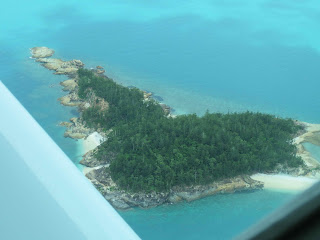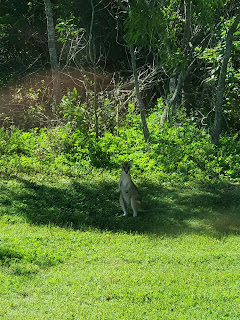March 10
The weather had finally been getting warmer, and more humid,
as we headed up the east coast of Australia. The weather in New Zealand hadn’t
been too bad, but it was a little cool and windy as we made our way around the
South Island. We were happy to have a couple of warmer days in Sydney, and
looking forward to more of the same as we continued. The humidity, however, was
almost as thick as in some of the South Pacific islands.
We were hoping that the rain that always seemed to be in
forecast would hold off for the day, as our planned excursion was a sightseeing
flight over the Great Barrier Reef. The weather was looking good as we arrived
in the morning:
Our tender ride in to town took about 20 minutes, nothing
out of the ordinary for this part of the world, as the Whitsunday Islands are
part of the reef and anchorages are often quite far out. When we stopped at
Cooktown a couple of years ago, which is farther north from here, the tender
ride was over a half hour long.
Once we arrived, our small group of 12 transferred into a
mini-bus from the tour company and rode about 40 minutes to the town of Proserpine
and the airfield. The group was just the size for the larger of the planes, and
we had all been assigned our seats ahead of time, so getting settled didn’t
take very long, and we took off for our hour’s tour over the reef.
The Great Barrier Reef is known as one of the Seven Natural
Wonders of the World, the largest living structure on the planet, stretching
1,400 miles along the coast of Australia in the Coral Sea. It is composed of
over 2,900 reefs and 900 islands, and, as everyone knows, is even visible from
space. Just hearing the numbers really doesn’t begin to explain the size; you
have to see it and marvel that you’re only looking at a tiny portion of it. So
let’s do that:
It took a full 20 minutes after leaving the bigger islands
of the Whitsundays behind to reach the outer edge of the reef, where the ocean
depth falls from 60 metres to 150 metres in a sheer drop. The views at the edge
were just spectacular!
On the way back we had a better view of the Whitsunday
Islands, as there had been some low clouds and rain squalls around when we flew
out.
 |
| This little island is called Heart Reef for obvious reasons |
 |
| This is probably a research facility, with a helipad on the roof. There's a lot of work being done to determine the effect global warming is having on the reef. |
Our pilot flew a direct line back to the airport – too bad
nobody told him to swerve a little in one direction or the other, because he
flew right over Crystal Serenity. Larry had the best shot:
Once we landed, deplaned and reboarded the mini-bus, we got
a view of some of the local wildlife. There are no kangaroos in this part of
Australia, but there are many of their smaller cousins, the wallabies. This guy
was watching us the same way we were watching him:
We were leaving Airlie Beach fairly early, so we didn’t
spend much time in town, but we had a nice view of the ship on the tender ride
back:
And again, another lovely sunset as we sailed around the
islands. It was cloudy, like the evening before, but not quite as interesting.
Although the full moon, a supermoon because of its proximity to Earth, had risen the evening before, we didn't see it then. Here’s the closest we could get. It was clouding over again, so we took an early photo, just after the sun set.
Now we were heading for Cairns, which is the biggest tourist
destination for visiting the Great Barrier Reef. In order to get us there
safely, we did have a Reef Pilot on board. It was never mentioned, but we did
see him in Marketplace at breakfast a few times, wearing his work shirt that
identified the Australia Reef Pilots Association. At least we knew we would have excellent guidance to Cairns and beyond.























No comments:
Post a Comment